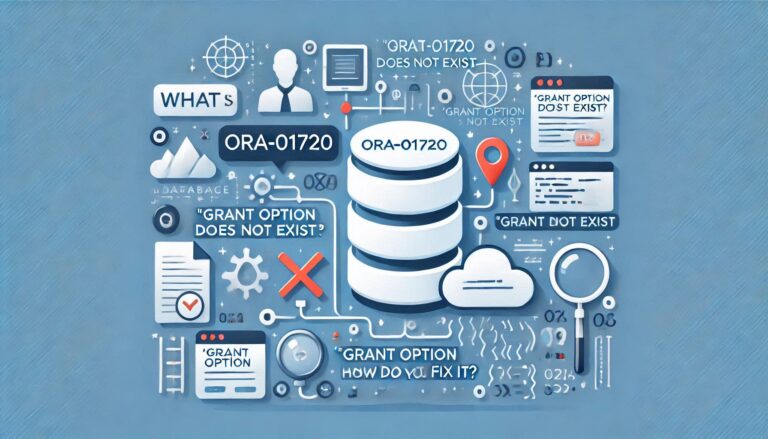Oracle Job Scheduler Commands for Task Automation
The Oracle Job Scheduler is a powerful tool that allows you to automate database tasks, helping you save time and ensure that repetitive or scheduled operations are performed consistently. Here’s a more detailed breakdown of how it works:
1. Schedules
A schedule in Oracle Job Scheduler defines when a job should run. It includes details such as:
- Start Date: The date and time when the job should first execute.
- Repeat Interval: The frequency at which the job should repeat (e.g., daily, weekly, monthly).
- End Date: The date and time when the job should stop running (optional).
For example, you can set a job to run every day at 8:00 AM or every first day of the month.
2. Programs
A program is a logical unit that defines what action a job will perform. It specifies:
- The type of operation to be performed (such as executing a stored procedure, calling a script, etc.).
- The name of the stored procedure, script, or package that will be executed when the job runs.
- The arguments for the program, if needed.
Programs can be created using PL/SQL or external scripts. For example, a program could be created to run a stored procedure like BILLING_PROC for generating bills.
3. Jobs
A job is the actual entity that links a schedule and a program together. It tells Oracle which program to execute according to a specific schedule. Jobs can also be manually triggered or stopped if needed. You can:
- Create a job that links to a specific schedule and program.
- Enable or disable a job as per the requirement.
4. Key Benefits of Using Job Scheduler
- Automation: It allows tasks to run automatically based on the defined schedules, reducing manual intervention.
- Consistency: Ensures that recurring tasks are executed on time without relying on human action.
- Resource Management: You can set up jobs to run during off-peak hours, ensuring they don’t interfere with regular database operations.
- Flexibility: You can run simple tasks like backups or complex jobs involving multiple PL/SQL procedures or scripts.
Example Use Cases:
- Daily Billing Jobs: Automatically run billing procedures at 8 AM every day.
- Database Cleanup: Set up jobs to archive old data or clean up logs at regular intervals.
- Backup Jobs: Automate backups that run during off-peak hours to ensure the system remains available during peak hours.
In summary, the Oracle Job Scheduler provides a flexible, scalable solution to automate repetitive database tasks, manage workloads, and ensure critical operations are executed without manual intervention.
1. Create a Schedule
BEGIN
DBMS_SCHEDULER.CREATE_SCHEDULE (
Schedule_name => 'DAILYREPORTGENERATION',
Start_date => SYSTIMESTAMP,
Repeat_interval => 'FREQ=DAILY;BYHOUR=11;BYMINUTE=30',
Comments => 'DAILY REPORT GENERATION'
);
END;2. Create a Program
BEGIN
DBMS_SCHEDULER.CREATE_PROGRAM (
program_name => 'DAILYREPORTGENERATION',
program_type => 'STORED_PROCEDURE',
program_action => 'DAILYJOB.REPORTGENPROC',
number_of_arguments => 0,
enabled => TRUE,
comments => 'DAILY REPORT GENERATION'
);
END;3. Create a Job
BEGIN
DBMS_SCHEDULER.CREATE_JOB (
job_name => 'DAILYREPORTGEN_RUN',
program_name => 'DAILYREPORTGENERATION',
schedule_name => 'DAILYREPORTGEN_SCHED',
enabled => FALSE,
comments => 'Daily report generation job'
);
END;4. Create Scheduler Job (Direct)
BEGIN
DBMS_SCHEDULER.CREATE_JOB (
job_name => '"MY_SCHEMA"."MV_REF_REPORT_DATA"',
job_type => 'PLSQL_BLOCK',
job_action => 'dbms_refresh.refresh(''"MY_SCHEMA"."STC_NEXT_REPORT_MV_DATA"'');',
number_of_arguments => 0,
start_date => NULL,
repeat_interval => 'FREQ=DAILY;BYHOUR=8;BYMINUTE=00;BYSECOND=00',
end_date => NULL,
enabled => FALSE,
auto_drop => FALSE,
comments => 'Converted report jobs'
);
DBMS_SCHEDULER.enable(
name => '"MY_SCHEMA"."MV_REF_REPORT_DATA"'
);
END;5. View Schedule Details
SET COLSEP ' | '
SET LINESIZE 120
SET PAGESIZE 50
SET FEEDBACK ON
SET HEADING ON
COLUMN schedule_name FORMAT A30
COLUMN schedule_type FORMAT A20
COLUMN start_date FORMAT A25
COLUMN repeat_interval FORMAT A40
SELECT schedule_name, schedule_type, start_date, repeat_interval
FROM dba_scheduler_schedules;6. Enable a Job
EXECUTE DBMS_SCHEDULER.ENABLE('SCOTT.MONTHLYREPORT');7. Disable a Job
EXECUTE DBMS_SCHEDULER.DISABLE('SCOTT.MONTHLYREPORT');8. Stop a Running Job
EXECUTE DBMS_SCHEDULER.STOP_JOB('SCOTT.MONTHLYREPORT');9. Drop a Running Job
EXECUTE DBMS_SCHEDULER.DROP_JOB('SCOTT.MONTHLYREPORT');10. Run a Job Immediately
EXECUTE DBMS_SCHEDULER.RUN_JOB('SCOTT.MONTHLYREPORT');11. Drop a Schedule
BEGIN
DBMS_SCHEDULER.DROP_SCHEDULE(
schedule_name => 'DAILYREPORTGEN_SCHED',
force => TRUE
);
END;12. Drop a Scheduler Job
DBMS_SCHEDULER.DROP_JOB (job_name => 'SCOTT.MONTHLYREPORT');13. Create Scheduler Job with Shell Script (Oracle 12c onwards)
BEGIN
dbms_credential.create_credential (
CREDENTIAL_NAME => 'MY_OS_USER',
USERNAME => 'oracle',
PASSWORD => 'oracle@123',
ENABLED => true
);
END;
EXEC DBMS_SCHEDULER.create_job (
job_name => 'my_script_task',
job_type => 'external_script',
job_action => '/export/home/oracle/test.sh',
enabled => true,
START_DATE => sysdate,
REPEAT_INTERVAL => 'FREQ=MINUTELY;byminute=1',
auto_drop => false,
credential_name => 'MY_OS_USER'
);14. Monitor Scheduler Jobs
SET COLSEP ' | '
SET LINESIZE 120
SET PAGESIZE 50
SET FEEDBACK ON
SET HEADING ON
COLUMN job_name FORMAT A30
COLUMN session_id FORMAT A10
COLUMN running_instance FORMAT A10
COLUMN elapsed_time FORMAT A15
SELECT job_name, session_id, running_instance, elapsed_time
FROM dba_scheduler_running_jobs;
SELECT * FROM DBA_SCHEDULER_JOB_RUN_DETAILS;
SELECT * FROM DBA_SCHEDULER_JOB_LOG;15. Get DDL of a Scheduler Job
SET LONG 10000
SELECT dbms_metadata.get_ddl('PROCEDURE', 'DUP_ACC', 'SCOTT') FROM dual;16. Copy Scheduler Job from One User to Another
EXEC DBMS_SCHEDULER.copy_job('SCOTT.MY_JOB_2','W3BUDDY.MY_JOB_2');17. Get Log Information of Scheduler Jobs
SET PAGESIZE 299
SET LINESIZE 299
COL job_name FOR A24
COL log_date FOR A40
COL operation FOR A19
COL additional_info FOR A79
SELECT job_name, log_date, status, OPERATION, ADDITIONAL_INFO
FROM dba_scheduler_job_log
ORDER BY log_date DESC;18. History of All Scheduler Job Runs
SET PAGESIZE 299
SET LINESIZE 299
COL job_name FOR A24
COL actual_start_date FOR A56
COL run_duration FOR A34
SELECT job_name, status, actual_start_date, run_duration
FROM DBA_SCHEDULER_JOB_RUN_DETAILS
ORDER BY ACTUAL_START_DATE DESC;19. Managing Scheduler Credentials
BEGIN
dbms_credential.create_credential (
CREDENTIAL_NAME => 'ORACLEOSUSER',
USERNAME => 'oracle',
PASSWORD => 'oracle@123',
ENABLED => true
);
END;
EXEC DBMS_SCHEDULER.drop_credential('ORACLEOSUSER');
SELECT owner, CREDENTIAL_NAME, USERNAME, ENABLED
FROM DBA_CREDENTIALS;
EXEC DBMS_SCHEDULER.SET_ATTRIBUTE(
name => 'ORACLEOSUSER',
attribute => 'password',
value => 'oracle'
);20. View and Manage Auto Task Jobs in Database
SELECT client_name, status, attributes, service_name
FROM dba_autotask_client;
BEGIN
DBMS_AUTO_TASK_ADMIN.disable (
client_name => 'auto space advisor',
operation => NULL,
window_name => NULL
);
END;
BEGIN
DBMS_AUTO_TASK_ADMIN.disable (
client_name => 'sql tuning advisor',
operation => NULL,
window_name => NULL
);
END;
BEGIN
DBMS_AUTO_TASK_ADMIN.disable (
client_name => 'auto optimizer stats collection',
operation => NULL,
window_name => NULL
);
END;For more details on Oracle Job Scheduler commands, visit the official documentation: DBMS_SCHEDULER Overview.






